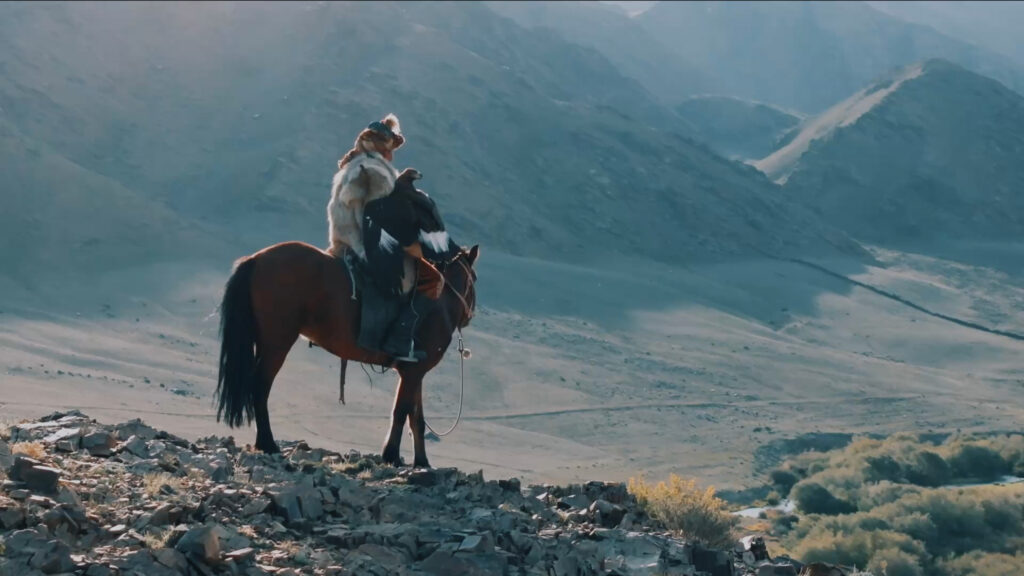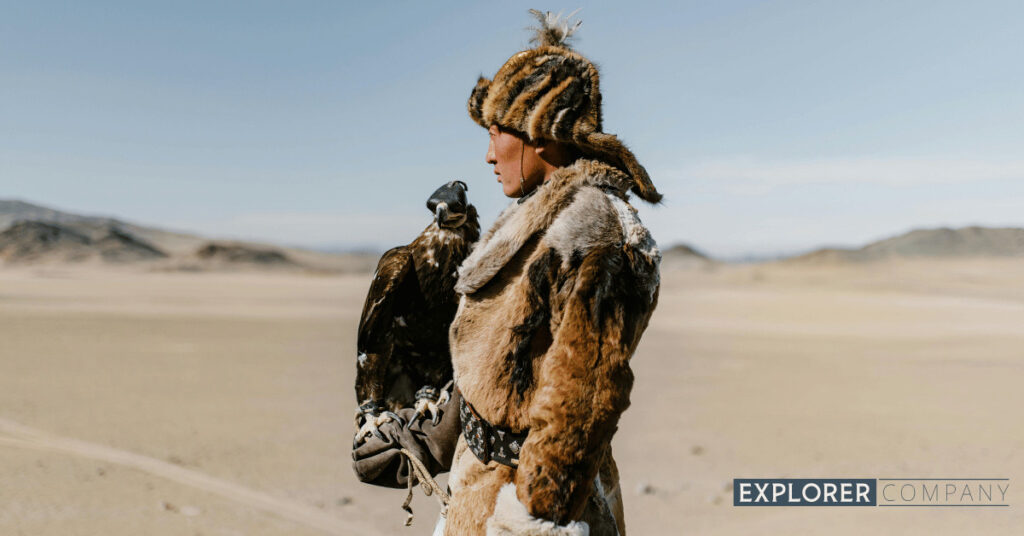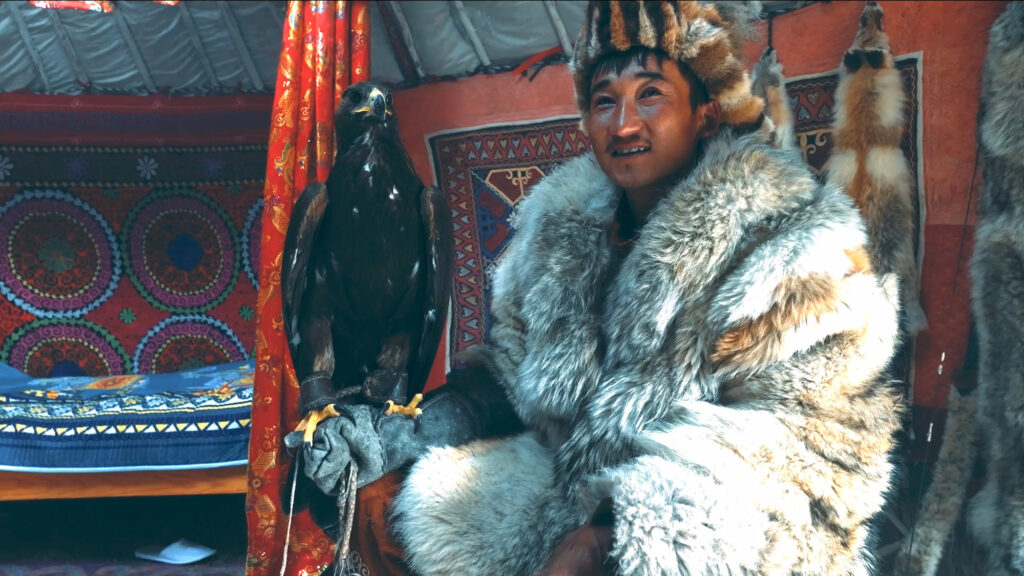There are few places left in the world where ancient traditions still breathe with such raw vitality, where a culture’s rhythm hasn’t been drowned out by the hum of modernity. Western Mongolia is one of those rare places. Out here, beyond the Altai Mountains, where the wind howls through wide valleys and the sky swallows the horizon, the Kazakh eagle hunters of Mongolia, also known as berkutchi, ride across the steppe, wrapped in heavy furs, with a golden eagle perched on their heavily gloved arm.

It’s not just a spectacle, it’s a way of life that has survived for centuries, passed down from father to son, and now, increasingly, from mother to daughter. Watching these hunters work alongside their birds is witnessing an ancient cultural practice thrive in the 21st century.
Who Are Mongolia’s Eagle Hunters?
Let’s start with the basics.
The Kazakh eagle hunters, known locally as berkutchi, belong to the Kazakh ethnic minority in Bayan-Ölgii Province, the westernmost region of Mongolia. Most are descendants of nomadic families who have roamed these lands for generations, long before borders carved up Central Asia into the countries as we know them today.
The Berkutchi bond with golden eagles dates back more than 2,000 years, to the ancient Turkic tribes of the Eurasian steppe. Traditionally, men began training as hunters as young teenagers, learning to care for and command these massive birds of prey. A well-trained eagle can spot a fox or rabbit from over a mile away and dive at speeds of 150 km/h, an extension of the hunter himself, graceful and ferocious. The benefits of this style of hunting are clear.
But it’s not as simple as capturing an eagle and calling it your hunting partner. Each bird is taken from the wild as a juvenile, usually a female since they’re larger and stronger than males, and trained through a long, delicate process that relies on mutual respect. The eagle must trust the hunter completely, enough to return after each hunt. After years of partnership, most hunters release their eagles back into the wild to breed, a gesture that symbolizes gratitude and renewal. This is the traditional way.
Why Are the Eagles Used For Hunting Today?
While there is a clear benefit to being able to remain astride your horse while hunting, the effort required to tame and raise a Golden Eagle in the modern era, where guns and ammunition are readily available, seems to outweigh any benefit. But most Eagle Hunters are not simply partaking in this tradition because it’s easy.
To truly understand the tradition, you have to understand the Kazakh people. Today, of the 100,000 Kazakh’s in Western Mongolia, only about 240 practice traditional eagle hunting. Primarily, this is a source of pride for them. A time-honored tradition that they don’t want to fade away as the generations progress. It’s also a source of fur, which is used to make traditional garments typically worn by the Kazakh people.
Life on the Steppe: Where The Eagle Hunters Live
I first met a Kazakh eagle hunter outside Sagsai, a remote village about 30 kilometers from Ölgii. His name was Aset, a quiet man with weathered hands and an easy smile. His ger, a round sheepskin tent that’s been home to nomads in Mongolia for centuries, sat perched on a slope overlooking an endless valley of gold grass and distant mountains dusted in snow.
The Kazakh eagle hunters live according to the seasons. In winter, when the snow drives prey down from the mountains, they hunt. Riding on horseback, cloaked in fox fur, they scan the slopes for movement. When they spot a target — a rabbit, fox, or marmot — they release the eagle. The hunt is short, intense, and silent except for the sound of hooves pounding through the snow and the eagle’s cry echoing across the valley.
In summer, the focus shifts. Families move their gers to greener pastures, tending livestock and maintaining their herds of yaks, camels, and horses. The eagles rest. Life is harsh out on the steppe, but deeply rhythmic, guided by weather and the cycles of the land.
While they likely live a much different life than you or I, there is much we can learn from them.
The Golden Eagle Festival
Every October, the hunters gather in Bayan-Ölgii for the Golden Eagle Festival, a celebration of their heritage and a way to keep this incredible tradition alive. For a few days, the wide steppe outside Ölgii fills with color: fur-lined coats, handmade saddles, and hundreds of horses stamping impatiently in the cold.
The festival isn’t staged tourism. But that’s what makes it such a great tourist attraction. It’s a reunion of families and a fierce competition where hunters show off their birds’ skills: speed, accuracy, and obedience. Watching an eagle streak across the sky to land perfectly on its master’s arm is electric. The air fills with cheers, the sound of horses, and the steady rhythm of Mongolian drums.
But the best moments happen off-stage, around campfires, sipping salty milk tea, listening to stories passed down through generations. It’s here that you realize how much this tradition means, not just as a sport, but as an identity.
The festival began in 1999 and has quickly morphed into one of the most popular attractions in Mongolia (alongside Naadam, of course). By design, it was meant to drum up international and national support for protecting this tradition. And it has succeeded. In 2011, the practice of Eagle Hunting was recognized by UNESCO as a living heritage, written proof it’s worth protecting.
This isn’t the only Eagle Festival in Mongolia, but it is the largest one.
A Tradition in Transition: The Future of Mongolia’s Eagle Hunters
In recent years, the story of the eagle hunters has captured global attention. Documentaries like The Eagle Huntress have shed light on the rise of young women taking up the craft, like Aisholpan Nurgaiv, who became the first female to compete in the Golden Eagle Festival.
Today, more women are learning to hunt with eagles, defying the centuries-old belief that it was strictly a man’s role. These young women are modern, educated, and equally at home with a smartphone as with a horse. Yet they choose to carry this ancient tradition forward, proof that culture can evolve without being lost.
Still, life in western Mongolia isn’t easy. Many families are moving to towns for better access to schools and healthcare, and younger generations are tempted by city life. Tourism, when done responsibly, plays a vital role in helping preserve the eagle hunting tradition by supporting local families and giving value to cultural continuity.
By visiting this region of Mongolia, tourists are helping to preserve this unique practice.
How to See Mongolia’s Eagle Hunters for Yourself
Most travelers meet the Mongolian eagle hunters in Bayan-Ölgii, the capital of the province. It’s a remote area, even by Mongolian standards, surrounded by the jagged peaks of the Altai Mountains and dotted with wide, glacial valleys. Reaching this part of the country is an adventure in itself.
You can fly from Ulaanbaatar to Ölgii, but the real magic lies in getting there by road. A self-drive Mongolia tour lets you experience the full sweep of the country, from the grasslands of central Mongolia to the arid beauty of the west. The drive is long, but the scenery is endlessly changing: sand dunes one day, alpine lakes the next.

If you’re up for the challenge, AVIS car rental in Mongolia offers fully equipped 4×4 rental vehicles and curated self-drive routes that include the eagle hunting region as part of the itinerary. Their Mongolia 4×4 self-drive tours make it possible to reach these remote communities at your own pace, all while crossing Tavan Bogd National Park, camping under the Milky Way, and winding through high mountain passes into Bayan-Ölgii.
By the time you arrive, you’ll already have a good understanding of the diversity of Mongolia.
When and Where to Go
The best time to visit the Kazakh eagle hunters is between September and March, when the weather turns cold and the hunting season begins. This is also when the Golden Eagle Festival takes place, typically during the first week of October near Ölgii.
Outside of the festival, it’s still possible to visit hunter families year-round. Many are happy to share their way of life, introducing travelers to their eagles and explaining the intricate relationship between human and bird. A local guide or translator helps bridge the language gap, but gestures, smiles, and shared tea go a long way here.
If you’re traveling independently, you can coordinate your visit through Avis Mongolia’s self-drive itineraries, which include stops and cultural encounters like this one.
What It’s Really Like to Visit an Eagle Hunter Family
Visiting an eagle hunter’s home isn’t a polished experience, and that’s what makes it so special. You might be welcomed into a simple ger, offered a bowl of airag (fermented mare’s milk), and invited to sit cross-legged by the stove.

Your host might show you the eagle’s equipment, hand-sewn leather hoods, tethers, and heavy gloves. You’ll learn how the birds are trained, fed, and handled, and maybe even watch a short demonstration if the season allows. There’s a quiet pride in how these hunters speak about their eagles. It’s not ownership, it’s a partnership.
There are no fences, no traffic, no noise but the low hum of life on the steppe. It’s in these small, quiet moments that Mongolia’s magic hits you hardest.
How to Travel Responsibly in Bayan Olgii
- When visiting eagle hunters, always approach the experience with curiosity and respect.
- You should be careful to choose experiences that directly support local families.
- Be mindful of photography, always ask before taking photos of people or their eagles, and avoid disrupting their routines.
The Kazakh eagle hunters of Mongolia are more than just a photo opportunity; they’re living bearers of a fragile tradition. Tourism, done with care, can help sustain their livelihoods and keep this heritage alive for generations to come.
Experience the Timeless Tradition of Eagle Hunting in Mongolia
The first time you watch a golden eagle soar across the Altai Mountains, you’ll understand why this tradition endures. There’s something so timeless about it, a rare link between human and wild, forged in trust, respect, and survival.
Not only is it a unique skill, but it’s fun to watch!
Visiting the Mongolian eagle hunters isn’t just about witnessing an ancient practice; it’s about experiencing a piece of living history that still thrives on the edge of the world.
If you dream of reaching Mongolia’s far western frontier, driving across empty plains, and meeting the Kazakh eagle hunters who still ride with the wind, consider exploring with Avis Mongolia. Their self-drive Mongolia eagle hunter tours make it possible to trace these ancient routes at your own pace and experience firsthand a world that still answers to the call of the eagle.

